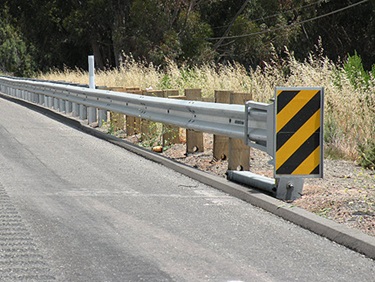
Guardrails and End Terminals: Enhancing Roadside Safety
by Mitchell Chermak
QForensics
Introduction
Guardrails play a crucial role in ensuring roadside safety by preventing vehicles from encountering roadside hazards such as rigid objects, steep slopes, cliffs, or bodies of water. These protective barriers are strategically placed along highways, bridges, and curves to minimize the severity of collisions. In this article, we’ll delve into the world of guardrails, with a specific focus on guardrail terminals—the critical components that mark the beginning or end of a guardrail system.
Guardrail Face: Redirecting Vehicles Safely
The guardrail face is the visible part of the barrier that faces the road. Its primary purpose is to redirect a vehicle back onto the roadway if it veers off course. Here are some key points about guardrail faces:
1. Composition: The most common guardrail design features galvanized steel w-beam panels that are lapped and connected with rigid splice bolts. Alternative designs include concrete barriers and cable barriers.
2. Considerations: There is no single “best” barrier system. Each has its own benefits and potential drawbacks that make it better suited to specific applications.
o Cable Barrier: High-tension Cable barrier is often the preferred choice in relatively wide medians or on roadsides where there is sufficient “safe space” beyond the barrier location. Cable barriers have the greatest dynamic deflection of the three most prominent barrier types and are thus more forgiving for the occupants of the impacting vehicle. While that behavior is desirable in locations that allow for it, many locations where barrier is installed feature hazards that are located just beyond the barrier.
o W-Beam Guardrail: W-beam guardrail is considered to be a semi-rigid barrier. It still allows for some dynamic deflection, thus reducing the impact forces exerted on occupants.
o Concrete Barrier: Concrete barrier is considered to be a rigid barrier. It has essentially no dynamic deflection (except for precast, temporary barriers, which can move somewhat when struck). This makes concrete barriers the least forgiving for the occupants of an impacting vehicle, but also the only option for many situations where no room for dynamic deflection exists because the hazard is located immediately beyond the barrier.
End Terminals: Absorbing Kinetic Energy
While guardrails are meant to protect drivers from roadside hazards, they themselves can become a hazard, especially at the end, where the guardrail is secured with a rigid anchor, and the narrow, relatively sharp end of the guardrail is exposed to impacting vehicles. Guardrail terminals are the critical components at the beginning and end of a guardrail system, particularly those located within the clear zone for approaching traffic. Their purpose is to anchor the guardrail for redirectional impacts while minimizing the severity of a direct impact. Let’s explore end terminals in more detail:
1. Energy-Absorbing Guardrail Terminals:
o These designs utilize various means to dissipate energy, gradually decelerating an impacting vehicle. This is most commonly achieved by extruding the guardrail through an impact head that kinks, cuts, or crushes the guardrail as it passes through the impact head.
2. Gating End Terminals:
o Gating end terminals are designed to give and allow a vehicle to pass if struck near the end. Gating terminals are designed to function as a redirective barrier after a specific distance from the end.
Crashworthiness Testing
Guardrail systems undergo rigorous crash tests to assess their performance. These tests simulate real-world collisions and evaluate factors such as occupant safety, vehicle redirection, and structural integrity. The results guide improvements in guardrail design and installation practices.
Global Safety Standards
Several safety standards govern guardrail design and installation worldwide. Notable ones include:
1. NCHRP Report 350:
o The crash testing standards described in Report 350 were superseded by the Manual for Assessing Safety Hardware (MASH), but are still applicable for many existing installations, depending on the installation date.
2. AASHTO MASH:
o Developed by the American Association of State Highway and Transportation Officials (AASHTO), MASH provides guidelines for crashworthy guardrail systems.
o MASH is the current crash test standard for safety hardware used on new construction in the U.S.
3. EN 1317 (European Standard):
o EN 1317 outlines requirements for road restraint systems in Europe.
o It covers various performance levels and impact scenarios.
Legal Liability in Guardrail and End Terminal Impacts
When functioning properly, guardrails redirect vehicles and lessen the severity of collisions with rigid objects and other roadside hazards. Similarly, end terminals protect drivers and save lives by preventing the blunt and relatively sharp guardrail end from impaling an impacting vehicle. However, design defects, improper installations, and improper placement can sometimes yield devastating results.
Design
Although the crash test standards referred to above are generally quite effective at keeping dangerous or inadequate designs off public roadways, changes to design parameters after testing or selective reporting of biased crash test samples can lead to the installation of inferior products. While occasional negative crash outcomes are unavoidable due to the unpredictable nature of roadway departures and high variability in impact conditions, it is important to consider the potential reasons behind a severe crash outcome. What type of guardrail terminal was hit? Does that terminal have any known issues or prior litigation associated with it? What are those issues, and are they applicable to the present crash? Was the terminal installed properly? Were the impact conditions within typical limits, such that acceptable performance could be reasonably expected? All of these questions and more can help shed some light on whether severe or fatal injuries resulting from a guardrail or terminal impact were exacerbated by dangerous conditions hidden in the device itself.
Installation/Placement
In addition to deficiencies in the guardrail design, issues with location, installation, maintenance, and repair can also expose drivers to hazardous conditions. In many cases, the entity responsible for maintenance and repair may not be immediately evident. It may be necessary to obtain discovery documents to determine if a government agency or a private contractor is responsible for guardrail maintenance and repair in that particular area. It is not uncommon for a state DOT to enter into an agreement with a private contractor to maintain and repair guardrail in a particular region, defined within the contract. The contract should also specify whether the contractor is responsible for inspecting the guardrail at certain intervals, or whether they are responsible only for repairs after they have been notified of the work needed. In any case, due to the high risk of having a damaged and unsafe guardrail located alongside a traveled roadway, many states have standards regarding the procedures and timelines for repair.
The installation of a roadside or median barrier is initiated either by satisfying one or more warrants or through an engineering study that considers multiple factors and determines a guardrail installation to be appropriate. These warrants are typically described in the roadway or roadside design manual for the state in which the roadway and guardrail installation are located. There is also national guidance provided on the subject by the AASHTO Roadside Design Guide. In many cases, the absence of a guardrail that is clearly warranted could leave the state DOT, the roadway project design engineer, or even the contractor, liable for accidents resulting from the absence of a barrier that should have been provided based on relevant design standards. Standards based on the type of roadside hazard, the distance to the roadside hazard, median width, and other factors, are typically presented as definitive, and well-defined criteria that render a guardrail either required, recommended, or optional. Other criteria, such as crash history and roadway curvature typically require a more detailed engineering analysis to draw definitive conclusions on whether a guardrail installation is warranted.
Conclusion
Guardrails, along with their end terminals, are unsung heroes of roadside safety. By redirecting vehicles and reducing crash severity, they provide the potential for saving lives and preventing catastrophic accidents. As we continue to improve our transportation infrastructure, let’s appreciate the silent guardians that keep us safe on the roads, while also remaining vigilant to root out dangerous conditions present in some guardrail installations even today.
_______________
Note: the infomration provided in this article is based on industry standards and practices. Always follow local guidelines and regulations when designing, installing, or maintaining guardrail systems.
 About the Author:
About the Author:
Mitchell Chermak is a Mechanical Engineer with Quality Forensic Engineering. He specializes in accident reconstruction and forensic engineering research and analysis. In over five years of reconstructing vehicle accidents, he has analyzed many cases involving roadside safety and guardrail design, installation and performance.
